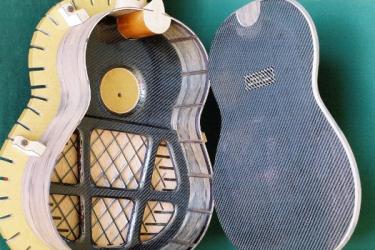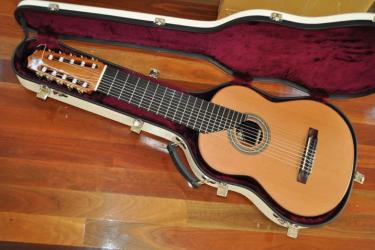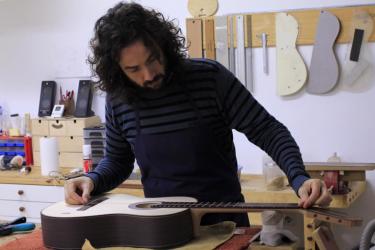
I’m delighted to have Ariel Ameijenda from Montevideo, Uruguay.
Q1. Could you please tell us a little about your luthiery and its history?
I was born in Montevideo, Uruguay in 1963 as the son of Manuel Ameijenda, one of the most famous guitar makers of my country. My father learned this difficult art from Juan Carlos Santurion, who had studied at Fleta's workshop in Barcelona, Spain in the early 1950′s on a scholarship granted by the Uruguayan government.
In my childhood, I used to play with woods and tools at my father's workshop. Soon, my father began to give me some small tasks, and then more complex ones. At the age of 14, under his guidance, I started to make my own instruments. When I was around 20, while studying musicology at the University, I kept working at my father's workshop with some independence, which eventually led me to create my own workshop at the age of 24.
Q2. Please describe your idea of a good sounding guitar, and what you do to achieve it?
I think the beauty of the guitar is the sound. The guitar with such divine quality should have well-balanced tones and a wide dynamic range. The treble should sound round and full, with a good sustain, clearness, and richness in harmonics. The bass has to be powerful and defined. To achieve these qualities, I pay extreme attention to the thickness of the top, and the exact doming with an accuracy of less than 0.01 mm. I make sure the bridge is very light with a height of no more than 8mm, plus 2mm to balance up with the nut. Acquiring the Spanish guitar making method is very important for all of that.
Q3. Please tell us about your idea of improving playability, and what you do to achieve it?
Apart from the height of the bridge which I have mentioned above, I make a meticulous alignment of the fingerboard. I use thin fret wires in Nickel Silver because they are easy to fine-tune. I give a slight radius to the fingerboard to make it more anatomical. It is a difficult task. As a result, I have achieved how to make a fingerboard on which it is very comfortable to play bar chords.
Q4. Please tell us your opinion about the traditional finishing method (French polish) and new methods (lacquer, catalysed finishing, etc).
I believe in French polish as the only method to achieve the necessary thin coating which doesn't inhibit the free vibration on the top. And for my health too!
Q5. Please tell us your opinion regarding shorter-scale guitars such as 640, 628 and 615mm in terms of playability, design, sound quality and volume. Is there an increasing need to cater to smaller-handed or female players?
I've been commissioned and built many guitars with 64cm scale, and the result has been always excellent in terms of sonority and playability because of the resulting reduction in tension. I try to balance it up by slightly reducing the thickness of the top.
In fact, one of the best guitars I've ever tried was a Domingo Esteso with 64 scale.
Q6. Many readers say they end up being very confused after trying many guitars. Could you give us some advice on how to examine the guitars' sound quality and playability at a shop or luthier, from the guitar-maker's point of view?
Well, the right guitar for you should be the one you fall in love with, at first sight. As to how it happens, there's not much to say. There's no explanation for why you love a particular sound of the guitar.
However, I would like to suggest one thing: Do not judge the quality of the guitar only by the powerful volume. Exploding sound is useless if there is not good balance across the fingerboard, valid dynamic range (the notes have to keep a good definition from pianissimo to fortissimo), variety of tone colours, and good sustain.
Q7. Do you offer any 'after-sales' service to customers - particularly customers who are nervous about making a substantial investment?
I'm very confident of the quality of my guitars. The long list of testimonials generously given by my customers, expressing their complete satisfaction speaks for itself (visit my website). These comments make me feel really proud of my work and also encourage me to keep on my path in ever greater depth.
Q8. How does the increasing rarity of some woods, rosewood for example, impact on your methods, and the quality of the end product?
Though certified Brazilian Rosewood still can be obtained in small and expensive amounts nowadays, the quality is far and away worse compared to my father's time. Generally, the woods nowadays come from very young trees, and the way it is cut, (which is a crucial thing for me), is not satisfactory. So I prefer Indian Rosewood with a very fine radius cut.
Q9. How do you see the future of this beautiful tradition in the 21st century?
I find the young generations very enthusiastic, with huge potential because of the amazing improvement in communications nowadays, which was inconceivable when I studied. This is undoubtedly a good thing. On the other hand, I find that the family luthier business tradition is in decline generally. The workshop is a place not just to learn the technicalities of guitar-making, but it's also a way of life, passed through the generations. Now my sons are with me in my workshop, I'm very aware of the importance of passing down my knowledge to them, sometimes, I realise that I'm not consciously teaching them, but they are absorbing this tradition by just being there.
I'm a little bit concerned about the shortage of quality timbers in the future and, without any doubt, it is going to be a serious issue soon. We will have to endure this, and find a way to come through.








